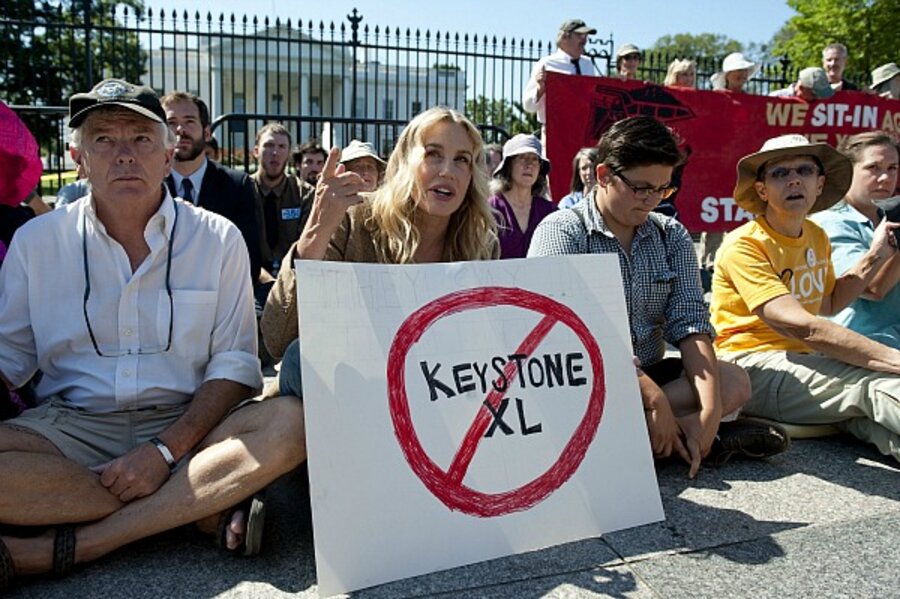Hundreds arrested protesting Keystone XL oil pipeline
| Chicago
More than 200 people were arrested outside the White House Saturday following two weeks of protests directed at President Obama in an effort to persuade him to deny final permitting of a controversial 1,661-mile pipeline that would carry oil from Alberta, Canada, to Port Arthur, Tex.
The arrests follow more than 1,000 arrests made since protesters arrived in late August to conduct sit-ins along Pennsylvania Avenue.
While a White House decision is not expected until December, the protests centered on an environmental impact statement released Aug. 26 by the US State Department that concluded there will be “no significant impact” on natural resources affected by the pipeline route.
The Monitor's weekly news quiz for Aug. 29-Sept. 2, 2011
If Obama approves the pipeline, it will begin a series of additional permits, approvals and authorizations, with operation set to launch in 2013. The $7 billion, 36-inch pipeline, called the Keystone XL, is expected to deliver 830,000 barrels, or 34.9 million gallons, per day across Montana, South Dakota, Nebraska, Kansas, and Oklahoma into Texas.
TransCanada, a leading North American pipeline operator, started operation of Keystone I, a 36-inch pipeline system, in June 2010, making it possible to deliver Canadian oil to markets across Midwest farmland in several states, from the Dakotas through Illinois. Keystone XL will incorporate a section of that existing pipeline in its delivery through the bottom half of the US.
Environmentalists say TransCanada has a failed safety record regarding its pipeline operations.
Federal regulators shut down Keystone I following two leaks, on May 7 and May 29. The first released 400 barrels, or 16,800 gallons, of crude oil in Sargent County, North Dakota. The second involved a leak at a pump station in Doniphan County, Kan., which released 10 barrels, or 420 gallons, of crude oil into the environment. The pipeline was restarted days later.
In a statement, Russ Girling, TransCanada's president and chief executive officer said “TransCanada takes all incidents very seriously … none of the incidents involved the pipe in the ground. The integrity of Keystone is sound.”
In its environmental impact statement, the US State Department said the existing pipeline experienced 14 spills since June 2010. Seven were 10 gallons or less, two were between 300 and 500 gallons, and one was 21,000 gallons.
The State Department estimates that the maximum the Keystone XL could potentially spill would be 2.8 million gallons along an area of 1.7 miles.
The Canadian government said Thursday it expects Obama to approve the pipeline.
Environment Minister Peter Kent told Reuters that his government “can look forward to eventual approval by the American government” and that TransCanada had “perhaps one of the best records of any pipeline operator” in North America.
Proponents of the pipeline say it will help the troubled US economy. TransCanada says the US will receive $20 billion through new job creation and local property taxes. The State Department report estimates that the pipeline will create between 5,000 and 6,000 new jobs that will generate up to $419 million in total wages. Nearly $7 billion will be added through additional costs, such as supplies and permitting.
Environmentalists and their supporters, including Nebraska Gov. Dave Heineman (R) and former Vice President Al Gore, say the pipeline will be a threat to national security because of its potential dangers and that it presents lasting harm to natural resources.
Bill Erasmus, the Assembly of First Nations regional chief for the Northwest Territories told CBS News Saturday that the pipeline will likely harm the Ogallala Aquifer, which covers 450,000 square kilometers and includes portions of Nebraska, South Dakota, Wyoming, Kansas, Colorado, Oklahoma, New Mexico, and Texas.
“If there is a spill in that aquifer, it will mess up the water for about four million people,” Mr. Erasmus said.
The State Department will conduct a series of public meetings Sept. 26-30 in Texas, Kansas, Montana, Nebraska, Texas, and South Dakota. A final public hearing is scheduled Oct. 7 in Washington. Another round of protests is expected to take place in Ottawa Sept. 26.





